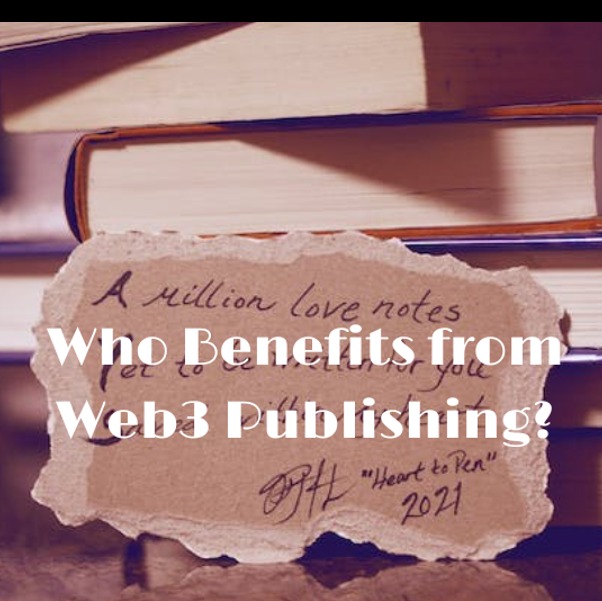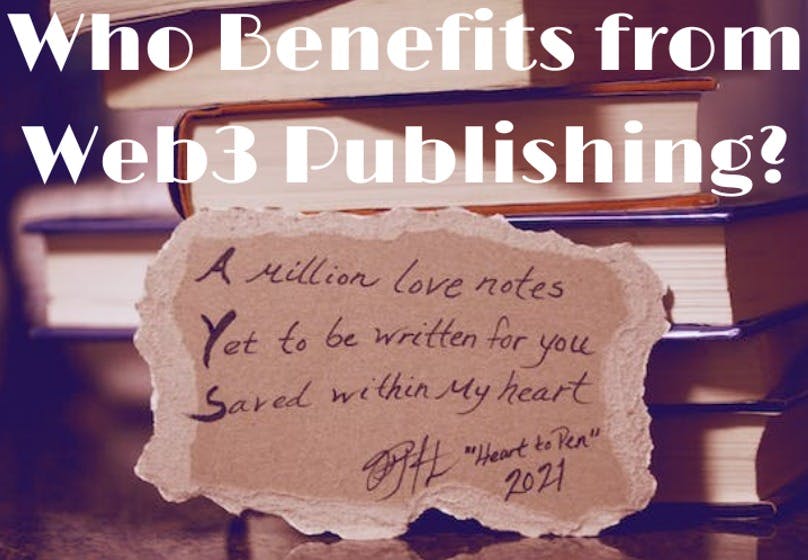More than any other technology before it, the World Wide Web opened up tremendous opportunities for content creators of all types. Initially, writers had the best prospects for Web publishing. It wasn't long before graphic and visual artists joined them. Audio and video creators would have their day a little later. Now, a new Web is emerging that is giving all types of creators even better opportunities. But it isn't just creators who will benefit from Web3 publishing.
Before we get to the punch line, let's discuss what Web3 publishing is. If you've been reading my writing for very long, you know I discuss three phases of the Web:
Web1 - The read phase.
Web2 - The read-write phase.
Web3 - The read-write-own phase.
Without reiterating what I've said before on this, Web3 is the emerging, decentralized Web that promises to deliver very specific benefits that are not embedded in Web2, or that may be more fully explored through Web3. But what are those benefits exactly?

3 People Who Will Benefit from Web3 Publishing
Virtually everyone will be able to benefit from Web3 publishing. Specifically, there are three classes of people who will benefit greatly from the decentralized Web, or what I call Web3.
Creators - Creators are those Internet citizens who create content for others to consume. They come in many stripes and include writers, visual and graphic artists, photographers, video content creators, podcasters, musicians, and others who may derive their skills from these basic creator classes.
Fans - Creators have fans. They may have just a few fans or millions. Whether celebrities like Taylor Swift and Brad Pitt or virtual unknowns, creators and their fans can enjoy the benefits of Web3 publishing.
Publishers - In a certain sense, one could call creators publishers, but it's feasible that creators can create while someone else does the publishing. This has been a trend for most of publishing history. While Web3 publishing empowers creators to be their own publishers, there may be some creators who would prefer that others wear the publishing hat while they themselves continue to create.
It's important to point out that creators are not necessarily individuals. They could also be businesses, non-profit organizations, and even decentralized autonomous organizations (DAOs).
What Are the Benefits of Web3 Publishing?
Now that I've laid the groundwork for who benefits from Web3 publishing, let's discuss what those benefits are. But first, let's discuss what makes Web3 publishing different from publishing in the past.
There are 6 main characteristics of Web3 publishing that make it distinct from Web2 publishing and pre-Internet publishing:
Decentralized - Decentralization can occur on multiple levels. For the purpose of this discussion, I'm going to point out that Web3 publishing consists of a decentralized technology layer. In other words, the technology used for Web3 publishing is decentralized, which means that the tools for publishing are distributed among various nodes rather than sit on one server.
Permissionless - Permissionless means anyone can log on and use the tools without being pre-authorized.
Peer-to-peer - Web3 publishing is peer-to-peer. That means no intermediary is necessary. One doesn't need a Facebook or Twitter to facilitate the publishing process. One can do it through seamless tools that makes it easier to connect with one's peers.
Pseudonymous - Web3 publishing tools allow participants to log in and protect their identities through tools and protocols that make it possible to use pseudonyms without penalty. That doesn't mean that everyone will use a fake name. Some people may use their real name, but they are not required to undergo a Know-Your-Customer (KYC) or identity-verification protocol in order to take advantage of Web3 publishing.
Data is freed - On Web2 platforms and services, users provide their personal information in order to access the service. That data is then mined and used by the collector for whatever purposes they deem, and it very often is not secure. With Web3 publishing, users gain access to platforms and services through a digital wallet with its own address. Users need never identify themselves by name or other personally identifying characteristics, unless they choose to. They own their own data and choose who to share it with while the Web3 publishing tools remain accessible to them.
Smart contracts - Smart contracts are computer programs that trigger when a pre-defined event occurs.
These underlying characteristics deliver specific benefits to creators, their fans, and Web3 publishers. It is those benefits that make Web3 publishing distinct from previous publishing models. Here are 10 benefits conferred from the above characteristics that creators, fans, and publishers can all enjoy:
Enhanced security - Because Web3 publishing is distributed using blockchain technology, the data distributed through Web3 networks is more secure. That means fewer hacks and a greater sense of personal security among all participants.
Privacy - Creators, fans, and publishers can obtain a greater degree of privacy because their personally identifying information is not splattered all across the Web where anyone can access or where smart hackers can break in and steal it. It also means that data can't end up on the dark net for sale.
Censorship-resistant - One problem with Web2 publishing platforms is that the platform can censor its participants by de-platforming them, de-monetizing them, or threatening to do so. This can't happen on truly decentralized Web3 platforms.
More diverse monetization options - Web3 publishing gives creators and publishers the ability to monetize their content in more ways than previously allowed. These monetization methods also provide fans with the ability to own, in part or in full, what is published by creators and publishers. In many cases, fans have the ability to earn from curating content or interacting with content published by their favorite creators.
Direct relationship between the parties - Creators, fans, and publishers do not need intermediary parties. Web3 publishing platforms and protocols allow creators and fans to more directly interact through the tools of the platforms and protocols.
Identity protection - Creators, fans, and publishers can operate pseudonymously. Even if they choose not to be pseudonymous, their identities can be protected using the tools available to them, such as zero-knowledge proofs and digital wallets.
Intellectual property protection - Because blockchain technology is immutable, creators and publishers have greater intellectual property protection against would-be content thieves. Fans can acquire the right to use intellectual property of their favorite creators and publishers using Web3 publishing tools such as non-fungible tokens (NFTs) and fractional investing with cryptocurrencies that allow for smaller monetary units than real-world money.
Token-gating - Content and access to creators and publishers can be obtained using tokens with specific utilities. Fans can support their favorite creators and publishers in ways that are comfortable for them while creators and publishers can offer access to their content, publications, communities, and other assets to whomever they want at a price all parties agree to.
More powerful community-building tools - Web3 publishing gives creators and publishers more powerful ways to build a community around their content and other assets. Fans benefit by getting involved in creator and publisher communities at a level that makes sense for them.
Greater freedom and autonomy - Creators, fans, and publishers alike are able to enjoy greater content, expression, and economic freedom through Web3 publishing tools.
The Future of Web3 Publishing
Web3 publishing is in its nascent stage of development. There are presently just a few options for creators, fans, and publishers when it comes to choosing the platforms and protocols that will secure the above benefits. Here are some of my favorite Web3 publishing platforms:
Hive - Hive empowers creators, fans, and publishers to establish a free account secured by multiple cryptographic keys and a secure digital wallet while providing monetization opportunities for all through content creation, curation, commenting, reading, and dapp development. Even fans can earn from interacting with others' content and can do so without creating content of their own. You can find me at Hive as Allen Taylor.
Readl - Readl provides a way for authors to publish their books, articles, stories, and other content as NFTs. You can find me on Readl as Allen Taylor. My book Web3 Social: How Creators Are Changing the World Wide Web (And You Can Too!) is available for minting, but there are only 4 copies left.
Mirror - Mirror provides writers and publishers a way to create and publish content that can be collected by fans on the Optimism network. The fans can then own an asset that they can resell on a secondary market or hold onto as a keepsake to show their support for their favorite writers and publishers. You can find me at Mirror as allentaylor.eth.
Paragraph - Paragraph is more versatile than either Hive or Mirror. Billed as a newsletter publishing platform, it can easily be more for the right creative entrepreneur. With token-gating features and NFT collecting features, creators and publishers can build an audience for their content while making it interactive. Fans can subscribe to their favorite creators and collect their content as NFTs on the Polygon blockchain. Creators and publishers can also hide their best content behind gated walls and allow access to fans with a variety of token-gating features. They can mint unique tokens, import tokens, or offer token-gated subscriptions. Paragraph combines the best features of Substack, Mirror, and Patreon. You can find me on Paragraph as Taylored Content.
I'm excited about the future of Web3 publishing. I believe greater opportunities are going to present themselves in the near future as the above platforms improve upon their offerings and new platforms and protocols join them. If you agree, feel free to collect this post.
Show Me Some Love!
If you like this post, show me some love. There are three ways to show me that you enjoyed reading this issue of Web3 Writings.
Share this post with your friends
Subscribe to the channel
Collect this post (only 3 mints available)


